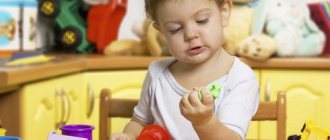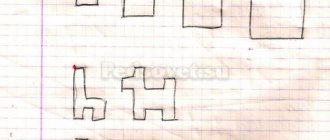Problems of games with clothespins
There are many games with clothespins. They can be divided into simple ones, which do not require devices and preparatory measures, games with templates and cardboard cutouts.
The purpose of games with clothespins is to enhance the cognitive interest of preschoolers.
Tasks:
- improvement of fine motor skills, strengthening of the muscles of the hands and fingers;
- improving the perception of shapes, colors, sizes;
- development of spatial perception;
- stimulation of speech abilities;
- expanding knowledge about the world around us;
- learning to count, forming mathematical concepts;
- stimulation of creative activity, development of imagination;
- development of perception by the organs of hearing and vision;
- improvement of memory, concentration;
- formation of a positive emotional state.
Games with clothespins for 2 years
You can play with clothespins from 2 years old. From the age of one, children willingly tinker not only with toys, but also with surrounding objects that they see in everyday life. Banks, basins, boxes - children willingly play with all this, but it is most interesting to play with clothespins. After all, they can be attached, they can be grabbed and pinched.
At 2 years old, the baby is already smart enough to understand by example how to properly attach and remove clothespins. It is enough to explain and show a couple of times, and the child is already playing on his own. Games with clothespins for 3 years old can be used to study colors, shapes, sizes. With a 4-year-old preschooler, you can become more familiar with the world around you. And for a child 5–6 years old, you can already come up with mathematical games and activities for learning counting and letters.
When teaching your child how to use clothespins, be sure to explain that they need to be held with 3 fingers when opening them. Otherwise, the baby may not be able to withstand the tension of the spring and end up pinching his finger. And then he won’t want to play anymore.
To make it more interesting for a 2-year-old child to learn how to use a clothespin, ask him to imagine that it is a small crocodile opening its mouth. Gently pinch the child, while saying that this is the crocodile trying to kiss him. If the baby resists and doesn’t like to be pinched, then you can show how the crocodile pinches the toy.
Use a sponge to pour water from one bowl to another
The game is in many ways similar to the previous one, but still gives the child slightly different sensations. A few tips: firstly, place a bowl of water on the left and an empty bowl on the right , then the child will pour water from left to right, this direction of action is important for placing his hand before writing. Secondly, it should be noted that it is more convenient to play with a sponge that is completely soft (without a hard part); if you were unable to buy a soft sponge, then cut off the hard part with a knife.
What clothespins to choose for the game
Clothespins are a cheap device and come in a variety of colors. It is advisable to purchase a set of different colors.
The material from which the clothespins are made can be any. The main thing is that the spring should not be stretched too tightly so that the child does not pinch his finger painfully. If you want to buy wooden products, look at how they are processed. The surface must be completely smooth, otherwise the child may drive a splinter under the skin. Plastic products are safe in this regard, although they are considered not environmentally friendly. Yes, the variety of colors for plastic sets is much wider.
The clothespins should be clothespins, large enough. You cannot use office clips for games. Firstly, they are too small for children's imperfect motor skills. Secondly, a small child may accidentally swallow them.
DIY games with clothespins
We offer games that can be organized not only in kindergarten, but also at home. Making them yourself couldn't be easier.
Find the clothespins
The game, recommended for children 2–3 years old, develops concentration. Attach clothespins in different places in the room, but not in visible places. It is important that they are no higher than the height level of a preschooler.
The game task is to find all the hanging objects. The child must peel them off and put them in a box. You can organize the game according to the “hot-cold” principle.
Letters on legs
The game is recommended for preschoolers of the older age group. Print out cards depicting different letters and stick them on cardboard to reinforce them.
Attach two clothespins to the bottom of the cards to create legs. You can play with these letters in different ways: imitate walking, dancing, or putting them in a round dance. From letters you can make words familiar to the child, while pronouncing them.
Food for animals
Make the faces of animals familiar to your child out of colored paper and cardboard and attach them to clothespins. Also print out pictures of the food these animals eat. Lay out the pictures and ask the preschooler to distribute food to the animals. The child takes a picture of food and attaches it to a picture of an animal.
Magic house
For a game intended for preschoolers 3–4 years old, you need a cardboard box, each inner side of which must be covered with colored paper of a certain color. Explain that the clothespins, which should be the appropriate color, are the elves, and the box is their magical home. The elves flew out for a walk, but forgot the way to the house. We need to help them find their home.
Children attach the elves to the walls of the box according to color. You can additionally write numbers on the box and ask the player to attach the same number of elf clothespins.
Let's catch a fish
The game is designed for learning colors. For this you need to prepare:
- small plastic basin;
- clothespins of different colors that will act as fish;
- cardboard circles of matching colors;
- a purchased or homemade fishing rod with a magnet attached.
The child lowers the magnet at the end of the fishing rod into the basin and catches the fish in it. Then he attaches them to a circle of the corresponding color.
Didactic game with clothespins
The activity is optimal for a 2-year-old child who is just learning to use clothespins. You need to attach them to different parts of the baby’s clothes, then invite him to take them off himself.
Treat for the hedgehog
Make several cardboard images of hedgehogs of different colors, indicate a specific number on each. The preschooler must attach the same number of clothespins of the same color to the back of the hedgehog so that it looks like needles. And the same number of fruits cut out of cardboard should be placed in boxes - these will be treats for the hedgehogs.
Wash the doll's clothes
The game is intended for girls 2–3 years old. Invite your child to wash their favorite doll's soiled clothes. Then hang it on a string and pin it. Clothing should be of different shapes and sizes: blouses, sundresses, scarves, socks.
Whose tail?
The lesson is useful for developing attentiveness, teaches you to quickly recognize objects, navigate, and correctly combine objects.
Make cardboard images of different animals, separately - their tails. Animals should be recognizable to a preschooler. Lay out the pictures, tell them that the animals have lost their tails, ask the child to find them and attach them.
There is another version of the game. Attach the wrong tails to the animals. Encourage your child to correct mistakes.
Count the syllables
This activity improves phonemic awareness and is intended for older preschoolers. Pronounce words with a clear separation of syllables, and the child must count the syllables by ear and attach the same number of clothespins to a cardboard sheet.
Garden
The game broadens one's horizons and introduces the preschooler to cultivated plants. Prepare cardboard images of root vegetables (radish, turnip, carrot) and vegetables growing on the ground (cucumber, zucchini, pumpkin, etc.). Fill the container with some cereal - these will be the beds. Insert pictures of vegetables and root vegetables into the container. Invite your preschooler to collect the crop and pull it out of the ground using clothespins.
Palette
The game is intended for learning colors with a 3 year old child. Make a circle divided into sectors according to the main colors of the palette. Also cut out small figures of the same colors and attach them to clothespins of the corresponding color. The game task is to attach the circles to the corresponding sectors.
Seasons of the year
The game for older preschoolers is intended to familiarize them with the world around them. Make a circle divided into 4 sectors. Each sector is divided into empty cells, onto which the child must attach landscape or story pictures corresponding to the seasons of the year.
Cups
You need plastic cups of different colors and matching clothespins. They need to be attached to the edges of cups of a similar color.
Fence
To play, make a small fence from scrap materials and paint its links in different colors. Buy clothespins in similar colors. Ask your preschooler to repair the fence and attach clothespins that match the color to its links. Or suggest alternating them according to the given colors.
Geometry game
The lesson is intended for preschoolers 4 years old who are getting acquainted with geometric shapes. Prepare cardboard images of different geometric shapes. Ask your child to count the number of corners of the shapes, attaching a clothespin to each.
Make beads
The lesson is intended for preschoolers 2–3 years old. Invite your child to make beautiful beads from multi-colored clothespins, which need to be attached to a string in a specific or random order.
Seven-flowered flower
Make a flower with petals of different colors from the basic palette. Ask your preschooler to distribute clothespins among the petals according to the color.
Sort by color
For an activity intended for preschoolers 3 years old, you need landscape, plot or object images in which a certain color predominates. For example, a picture of carrots - the orange color predominates in it. Or a picture of a clear sky - blue color predominates in it. Ask your child to attach a clothespin of the corresponding color to each picture.
Play with two- or three-layer insert frames (puzzles)
Multilayer frame inserts are simply amazing toys; they combine the functions of both a puzzle and a platform for a story game. As a rule, such inset frames show the child one object in different sections, for example, a house (bus, car) inside and outside. This representation of an object contributes to the development of the child’s imaginative thinking. And it’s just incredibly interesting! Even parents
For example, the puzzle “House of Hares” (My-shop, Read) consists of the following layers: on the lowest layer the bunnies woke up and got out of their beds (in this case, you can get each hare and play a small plot game with them), on the next layer the awakened hares have already begun to carry out some kind of activity: drinking tea, taking out toys, on the third layer the house is shown from the outside and you can see what the hares are doing on the street. Here are interesting options for two-layer puzzles - House or Bus.
In this game, the child learns to distinguish the details of each layer and combine them not just by the similarity of objects (as in ordinary frame inserts), but by meaning.
Templates for games with clothespins
You can make pictures for games with clothespins yourself, or you can download and print ready-made free templates, which makes preparing for the lesson easier. It is much more interesting for a preschooler to attach clothespins to funny and cute images than to a regular piece of cardboard. That is, the child’s interest in the process and the result increases.
Templates are images without certain parts, to complete which you need to attach clothespins to the picture in specific places. That is, you need to supplement the image so that it becomes complete. For example, the image of the sun, the child complements it with rays. Or a flower - it needs to make petals. The hedgehog needs to add spines on his back, the octopus - tentacles, the dragonfly - wings, the fish - fins, the bunny - ears, the cactus - thorns. When playing with a rainbow pattern, clothespins need to be attached in accordance with the colors, and when choosing a glove pattern, they need to be attached to the fingers.
Pour water with a pipette or bulb
Another activity to develop your child's finger strength and fine motor skills. The essence of the lesson is this: you need to pour water from one container to another using a rubber bulb (syringe), a culinary dispenser (as in the photo) or a pipette. The containers can be anything, however, it seems to me that using an ice mold makes the game much more interesting. So, Taisiya and I take water in a small bowl and fill some cells of the form, then we check which cells are empty and which are full, if desired, we count how many cells are filled. Then collect the liquid from the cells back into the bowl.
The most difficult thing for a child in this game is to learn the sequence of actions: first we press on the bulb, then we lower the tip into the water, we collect water, then, without pressing, we transfer it to another container, etc. At first, hold the child’s hand in yours and act together, so the baby will better understand the essence.
Now there are very cute pipettes on sale from Learning Research, they are great for a child's hand. Available in the KoroBoom store.
Try not to pour a lot of water for the game, pour as much as you and your baby can pour back and forth in one game. If you are using a small medicine dropper, the containers should also be very small. If desired, the water can be colored with food coloring.
Yes, and remember that you need to pour water before playing, as well as clean up your work area together with your baby; you can read more about this in the article about development using the Montessori method.






